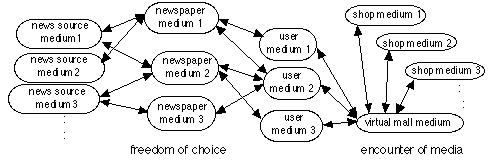
I have proposed Metamedia Architecture in the second FIPA meeting. Based on the architecture, this document describes Interactive Multimedia Applications as a proposal of agent-based applications for the Tokyo meeting.
Interactive Multimedia Application is distinguished from "regular" or "traditional" multimedia applications by its symmetric use of communication. With traditional multimedia applications, either CD-ROM or WWW-based, the communication between human end user and the application program is usually asymmetric: lots of multimedia data (sounds, graphics, movies etc.) to receive, just a little (typically mouse clicks and text input from the keyboard) to send.

On the other hand, Interactive Multimedia Application consists of agents talking to each other, which represent multimedia information.

Examples of such applications include:
In the FIPA Agent Basic Capability (ABC) List, Agent <->Agent interaction is most crucial to implement the Interactive Multimedia Application. We need the following technologies to standardize this level: